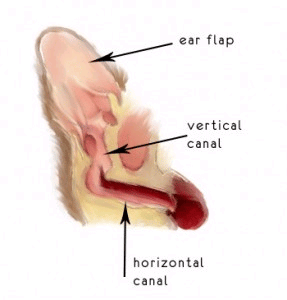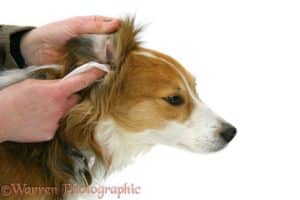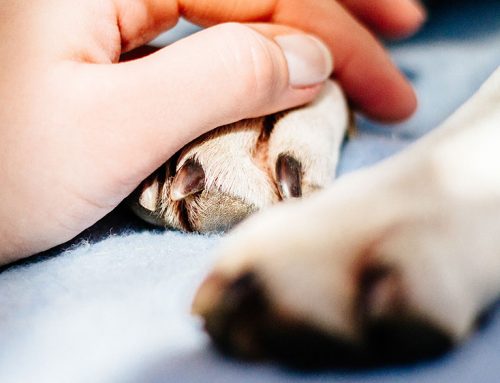
There are many things that dogs are good at and one of these is getting ear infections.
Dogs have an L-shaped external ear canal which facilitates the trapping of moisture, yeast and bacteria. This combined with the limited ventilation of the L-shaped canal and the lid created by the floppy ears of some breeds means that the inside of the ear canal is the perfect dark, moist environment for bacteria and yeast populations to blossom, leading to ear infections, or otitis.
Structural problems such as a narrowed ear canal can also predispose some dogs to developing otitis on a regular basis. Other dogs may develop frequent problems due to underlying skin allergies, which can also affect the lining of the ears as the ears are lined with a type of modified skin. Inflammation if the lining of the ears makes the skin barrier prone to invasion by bacteria or yeasts, making ear infections more likely.

Signs of ear infections include scratching of or around the ears, shaking of the head or ears more frequently than usual and bad smells coming from the ear canals. It is sometimes possible to see that the ear canals are red and inflamed, or contain a lot of discharge, or ‘dirt’ than usual.
(pinna) needs to be lifted out of the way to visualise the top of the ear canal. Although ear infections are certainly not emergencies, it is best to seek veterinary attention sooner rather than later.
Ear infection are itchy and painful, and if left untreated, can extend from the external ear canal down into the middle and inner ears, which contain delicate structures. All that head shaking and vigorous scratching can also lead to rupture of the blood vessels between the layers of the pinna, causing an aural haematoma, or blood filled pinna.
Diagnosis of otitis usually starts with your vet cleaning and examining the ear. The next step is to examine the discharge from the ear to get an idea of whether the infection involves yeast or bacteria.
New Products for Flea & Tick Prevention
Two new products have recently been released for flea and tick protection. Both are administered orally, and so far are only available for dogs—unfortunately not for cats.
![]()
“Nexgard” provides protection against both fleas and ticks for a full month.

“Bravecto” provides protection against fleas for 3 months and against paralysis ticks for 4 months.
Both products are a new type of drug technology, and both are presented as a palatable tablet which dogs accept readily. While Nexgard and Bravecto are new to Australia, the research on efficacy of protection is sound, and they have both been on the market in other parts of the world for a few years, so GVH is happy to recommend them.









